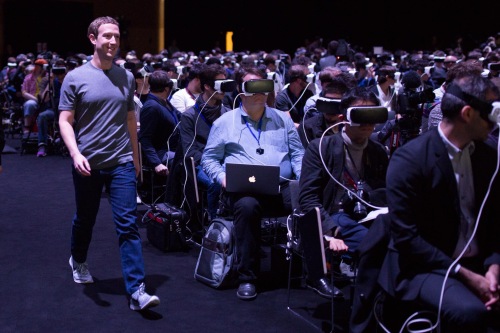
A few weeks back, at Mobile World Congress, news came out about many new smartphones and how those smartphones might be used, such as virtual reality viewers. To underscore that VR tie-in, Samsung offered its Gear VR headset for free if you pre-ordered either the Galaxy S7 or S7 Edge. It wasn’t the VR pre-order gear that drove it home to me so much as the photo from one of MWC’s conferences, where the Zuck is seen strolling past VR-gear-wearing geeks stretching back as far as the camera lens can see.
I’ve tried out a VR viewer once, just to see how it felt, and to me it felt heavy, awkward and claustrophobic. Considering how bad I think it looks on someone else’s head I can only imagine how bad it looked on mine. The technological equivalent of an Alien xenomorph face hugger. Perhaps I viewed the wrong 3D video, but I have not been blown away by viewing 3D with these devices. But then, perhaps I’m not their target demographic, which appears to be white twenty-something ADHD narcissistic misogynistic males.
This is not the first time we’ve tried to wear a computer on our heads. Remember Google Glass?
Google Glass was supposed to be the cool way that cool kids could augment reality with hardware and Android. Initially hailed as he Next Great Thing, it quickly degenerated into the butt of massive criticism over privacy (primarily) and safety issues.
Before Glass the only way you could experience anything even close was with military gear, such as helmet mounted displays (HMDs) for cuing weapons systems on military aircraft.
So here we have Glass, which was meant to be something stylish, something that would be as lightweight and physically unobtrusive as possible being run out of the market, and essentially being replaced with a piece of head gear more in line with the what attack helicopter and fighter jocks wear when they’re chasing terrorists across the bad lands of the middle East.
It’s interesting why that is. Was it the price? Google Glass cost $1,500 to purchase. It meant that if you had one and were using it then you immediately telegraphed how rich you were that you could throw $1,500 at a piece of hardware, a solution looking for a problem. Sounds like a lot to spend until you start looking at the minimum $599 cost needed for a consumer Oculus Rift, and that’s not even including the two grand you’ll need to drop on a PC powerful enough to drive it if your current crappy PC isn’t up to it. And heaven forbid if you’ve got a Mac, because Oculus Rift’s Luckey says you Mac just isn’t good enough.
I personally believe it was the target audience (the same audience that helped spawn #gamergate). The ADHD males that have been flocking to the VR gear are the same group that helped to drive Glass out of the market via social media. The VR headgear is what the child-man wants to have strapped to the front of his face, so he can be further immersed in his misogynistic hyper-violent video games. Glass was aimed at the more mainstream adult customers who really wanted augmented interaction with their environment.
And to prove that the current VR wave is the bastard child of the current societally tone-def insensitive bastards driving the current technology companies, a number of them led by folks like the aforementioned Palmer Luckey, the founder of Oculus Rift, think that VR could be used to placate the world’s poor. Never mind that the money spent to buy their VR toys would provide a direct decent living for the very poor they want to placate virtually. No, these folks believe that their latest is what the world really needs to be happy. To quote from the Wired story “VR Will Make Life Better—Or Just Be an Opiate for the Masses”
“There’s something hideously limited about an imagination that sees VR as a tool for placating the world’s poor,” says Ethan Zuckerman, director of the MIT Center for Civic Media and author of Rewire: Digital Cosmopolitans in the Age of Connection. “This feels like a Western fantasy, a dream that a new technology will solve a problem, one those trying to solve it don’t really understand.”
Zuckerman, for his part, does understand the problem. He’s spent many years in Ghana and Kenya, spending much of that time running the high-tech NGO Geekcorps, and rejects the notion that VR will be a meaningful panacea. “The idea that we can make gross economic inequalities less relevant by giving Africans virtual bread and circuses is diabolical and delusional.” (emphasis mine)
No, I think this is going to be as fabulous a success as original web-based VR was back in the mid 1990s, when the browsers and the Web first hit the marketplace and we were playing with Virtual Reality Modeling/Markup Language, or VRML. It was the hottest thing when first introduced, but over the years it’s become a W3C standard, which has pretty much killed it, leaving white papers and barely living open source projects in its wake.
The commercial hardware will be introduced to great fanfare, much like Microsoft’s Kinect was, it’ll fill a number of homes much like Microsoft’s Kinect did, and it will eventually fade from view and social consciousness, gathering dust and not much else, much as Microsoft’s Kinect has. I can’t wait.





You must be logged in to post a comment.